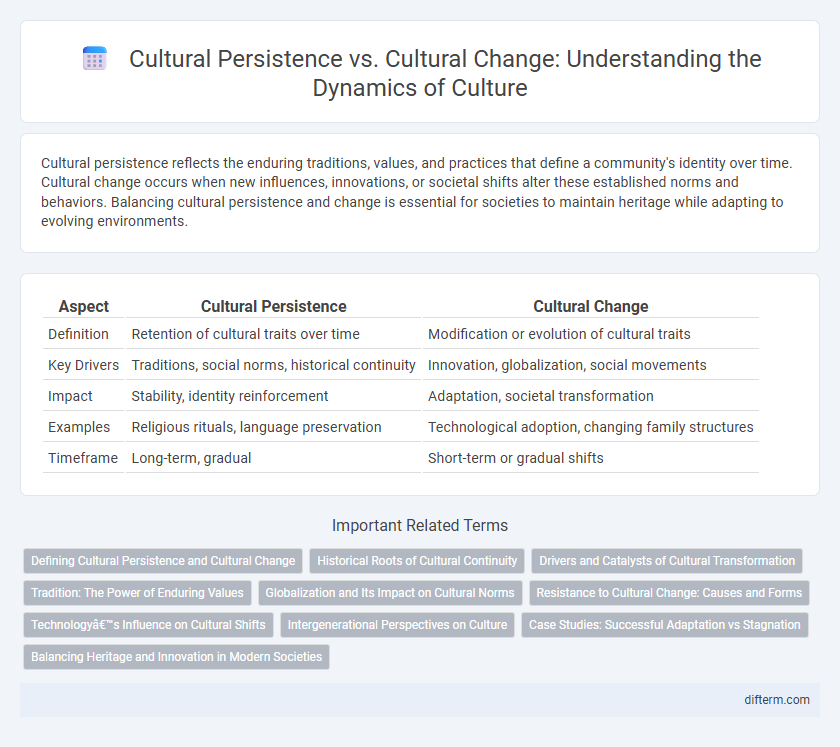Cultural persistence reflects the enduring traditions, values, and practices that define a community's identity over time. Cultural change occurs when new influences, innovations, or societal shifts alter these established norms and behaviors. Balancing cultural persistence and change is essential for societies to maintain heritage while adapting to evolving environments.
Table of Comparison
| Aspect | Cultural Persistence | Cultural Change |
|---|---|---|
| Definition | Retention of cultural traits over time | Modification or evolution of cultural traits |
| Key Drivers | Traditions, social norms, historical continuity | Innovation, globalization, social movements |
| Impact | Stability, identity reinforcement | Adaptation, societal transformation |
| Examples | Religious rituals, language preservation | Technological adoption, changing family structures |
| Timeframe | Long-term, gradual | Short-term or gradual shifts |
Defining Cultural Persistence and Cultural Change
Cultural persistence refers to the continuity and endurance of cultural beliefs, practices, and values over time, maintaining identity despite external influences. Cultural change involves the transformation or evolution of cultural elements, often driven by factors such as globalization, technology, or social movements. Understanding the dynamics between cultural persistence and change is crucial for analyzing how societies adapt while preserving core traditions.
Historical Roots of Cultural Continuity
Historical roots of cultural continuity reveal how traditions, values, and social norms are preserved across generations through rituals, language, and institutions. These deeply embedded elements create resilience against rapid transformations, maintaining a culture's identity amid external influences. Understanding this persistence offers insights into why some cultural practices endure while others evolve or fade away.
Drivers and Catalysts of Cultural Transformation
Drivers and catalysts of cultural transformation include technological advancements, globalization, and social movements that challenge traditional norms and values. Economic shifts and political reforms also play critical roles in reshaping cultural practices by influencing societal priorities and resource distribution. Persistent cultural elements often adapt selectively, blending historical identities with emerging influences to maintain relevance across generations.
Tradition: The Power of Enduring Values
Enduring traditions anchor societies by preserving core values that shape cultural identity and social cohesion through generations. These deeply ingrained customs reinforce shared beliefs and rituals, providing a stable framework amid rapid societal changes. The power of tradition lies in its ability to transmit collective memory and moral guidance, ensuring cultural persistence despite external influences.
Globalization and Its Impact on Cultural Norms
Globalization accelerates cultural change by facilitating the rapid exchange of ideas, values, and practices across diverse societies, challenging traditional cultural norms. Despite this, many communities exhibit cultural persistence through the conscious preservation of languages, rituals, and identities that resist homogenization. The interplay between global influences and local resistance shapes the dynamic evolution of cultural landscapes worldwide.
Resistance to Cultural Change: Causes and Forms
Resistance to cultural change often arises from deeply rooted traditions, strong social identities, and perceived threats to established norms and values. This resistance manifests in various forms such as cultural lag, where certain groups cling to outdated customs despite evolving environments, and active opposition through movements or policies aimed at preserving heritage. Understanding these causes and expressions illuminates the complexities of how societies maintain continuity amid pressures for transformation.
Technology’s Influence on Cultural Shifts
Technology drives cultural shifts by reshaping communication, social interaction, and knowledge dissemination, accelerating cultural change across societies. Despite rapid innovation, core cultural values and traditions often persist due to deep-rooted social structures and collective memory. The interplay between digital advancements and cultural persistence creates dynamic cultural landscapes marked by both continuity and transformation.
Intergenerational Perspectives on Culture
Intergenerational perspectives on culture reveal how cultural persistence maintains core traditions, values, and practices across generations, ensuring identity continuity within communities. Simultaneously, younger generations often introduce cultural change through the adaptation of new technologies, global influences, and evolving social norms, fostering dynamic cultural evolution. This balance between persistence and change shapes societies by blending historical heritage with contemporary innovation.
Case Studies: Successful Adaptation vs Stagnation
Case studies highlight that societies embracing cultural change through innovation and external influences achieve successful adaptation, fostering economic growth and social cohesion. In contrast, cultures resistant to change often experience stagnation, marked by declining relevance and diminished global influence. Examples like Japan's Meiji Restoration contrast with North Korea's isolation, illustrating outcomes of adaptability versus persistence.
Balancing Heritage and Innovation in Modern Societies
Balancing heritage and innovation in modern societies requires cultural persistence that safeguards traditions while embracing change through adaptive practices. Preserving historical customs ensures a continuous identity, yet integrating new ideas fosters social evolution and creativity. Societies that maintain this equilibrium promote resilient cultural frameworks capable of thriving amid globalization and technological advancements.
Cultural Persistence vs Cultural Change Infographic

 difterm.com
difterm.com